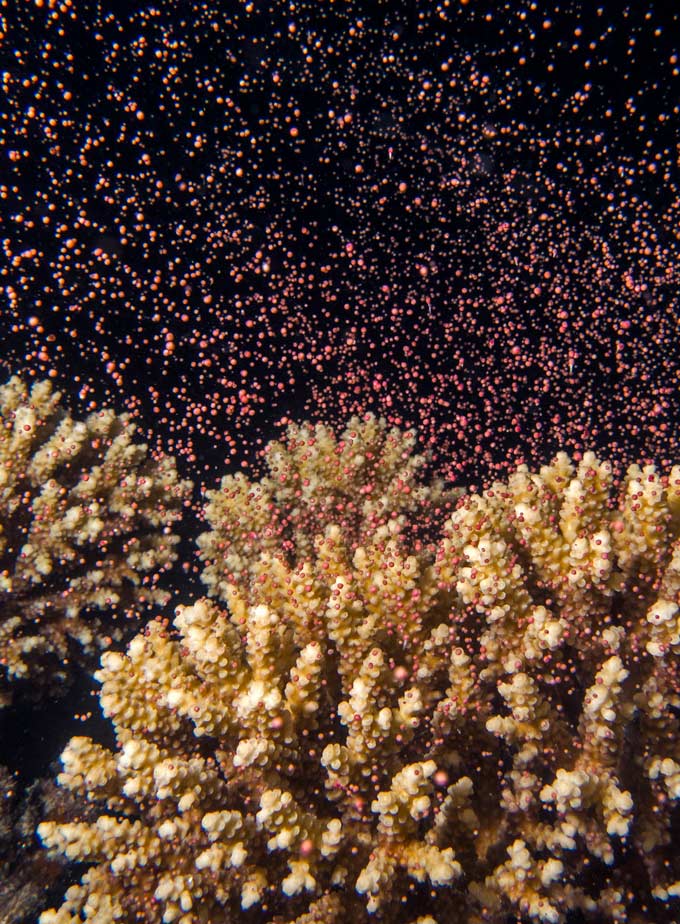
While spawning, some corals release masses of plump, pink egg-sperm bundles simultaneously across a reef — tantalizing snacks for fish. But warmer seawater temperatures may be throwing off the timing of those synchronized releases.
T. Shlesinger
Bad timing for coral sex might be an underappreciated threat of climate change.
Spawning is out of sync for at least three widespread coral species in the Red Sea, says Tom Shlesinger, a marine biologist at Tel Aviv University. And warmer seawater temperatures could be playing a role.
Records from the 1980s suggest that whole swaths of corals from particular species typically let colorful egg-sperm bundles float out of their tiny mouths and up into the water on the same few nights a year, Shlesinger says. Released in a big synchronized cloud, the sex cells separate from one another, gaining a chance at fertilization during the brief time that they survive on their own in seawater. It’s “a wonder of nature,” he says.
But after four years of recent monitoring, Shlesinger argues that three of the five species studied no longer tightly synchronize their species-wide gamete releases. And few if any new colonies of these kinds of corals are showing up in recent surveys, so the species might dwindle away in the region, Shlesinger and Yossi Loya, also at Tel Aviv University, warn in the Sept. 6 Science.
Shlesinger didn’t set out to compare local spawning synchrony. But “it’s something that kind of grabbed me,” he says. After realizing some corals weren’t spawning when expected, “I started going to the sea at night.”
We summarize the week's scientific breakthroughs every Thursday.
By the second year of his questing, he was snorkeling or diving several hours a night during spawning months. Some 150 species of corals mingle in the long, narrow gulf of the Red Sea that stretches northeast past Eilat in Israel and Aqaba in Jordan. Unlike the Great Barrier Reef in Australia, where more than 100 coral species can release their gametes together on the same night, the Red Sea’s corals spawn one species or a few at a time on their own special nights.
Shlesinger had seen corals spawn elsewhere, but the night he finally got the timing right to catch an event in the Red Sea was “magical,” he says. He first spotted small, red egg-sperm bundles drifting up from a single coral. Soon he was swimming through “a colorful snowstorm” of little red capsules rising from hundreds or even thousands of corals.
A whole species can synchronize its spawning to the same half-hour. That precision depends on an interlocking set of environmental cues. Water temperature, sunlight and wind affect the month of the event, researchers have found. The phase of the moon matters in determining the night, and local sunset cues the time.

Data from 1980 to 1982 on the five studied species show consistent, synchronous patterns of mass spawning, based on regular lab exams of coral samples plus nighttime swims. But during 225 swim surveys from 2015 through 2018, Shlesinger discovered that only two of the five species still managed to spawn en masse during just a few nights. Three others didn’t synchronize tightly. In 2018, for instance, at least a few big lumps of the brain coral Platygyra lamellina spawned just about every night from June 12 to July 18. Mini releases don’t create a thick enough soup of gametes to make fertilization likely or for there to be a lot left over after fish finish feasting on the bundles.
The moon still waxes and wanes regularly, but other spawning cues may be wavering out of sync with it. For instance, since 1982, when the earlier surveys were conducted, water in the northern part of the gulf has warmed about 0.31 degrees Celsius per decade, the researchers calculate. (Pollutants, especially hormone-disrupting ones, might also be sabotaging coral reproduction, the scientists say.)
Corals around the world are already threatened by rising temperatures, which can cause corals to severely bleach and die (SN: 1/4/18), among other threats. Various efforts are under way to help rehab and protect these spectacular ecosystems (SN: 10/18/16).
Biologists have certainly fretted that climate change might also knock coral spawning synchrony askew, says James Guest, a coral biologist at Newcastle University in England. It’s not easy finding old records with methods comparable with today’s, however. For instance, older data might have missed some of the smaller blips in synchrony that showed up in Shlesinger’s diligent swimming, Guest says.
And some corals have a bit of natural play in their timing, says Taryn Foster, a coral biologist at the California Academy of Sciences in San Francisco. In her work off the coast of Australia, she’s found that corals in Scott Reef observe a sort of leap year. Every two or three seasons, they split their spawning into two separate bursts, thus coping with the way moon phases cycle faster than annual cues. These corals, however, break their spawning into roughly equal parts. It’s the small bursts of spawning described in the new study that she worries about.
That’s the menace to the three corals, Shlesinger says. In five sample plots in each of two areas at Eilat that he monitored, some other species were doing well, but he struggled to find youngsters for the three out-of-sync coral species. For two of them, he often found no new youngsters at all.






